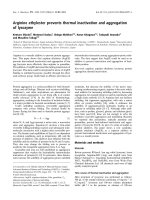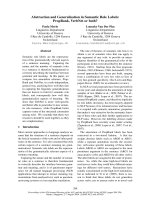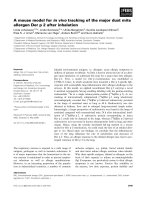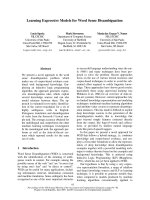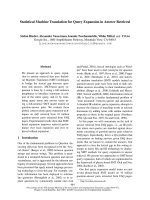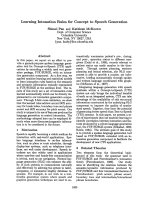Báo cáo khoa học: "Learning Predictive Structures for Semantic Role Labeling of NomBank" pptx
Bạn đang xem bản rút gọn của tài liệu. Xem và tải ngay bản đầy đủ của tài liệu tại đây (141.78 KB, 8 trang )
Proceedings of the 45th Annual Meeting of the Association of Computational Linguistics, pages 208–215,
Prague, Czech Republic, June 2007.
c
2007 Association for Computational Linguistics
Learning Predictive Structures for Semantic Role Labeling of NomBank
Chang Liu and Hwee Tou Ng
Department of Computer Science
National University of Singapore
3 Science Drive 2, Singapore 117543
{liuchan1, nght}@comp.nus.edu.sg
Abstract
This paper presents a novel application of
Alternating Structure Optimization (ASO)
to the task of Semantic Role Labeling (SRL)
of noun predicates in NomBank. ASO is
a recently proposed linear multi-task learn-
ing algorithm, which extracts the common
structures of multiple tasks to improve accu-
racy, via the use of auxiliary problems. In
this paper, we explore a number of different
auxiliary problems, and we are able to sig-
nificantly improve the accuracy of the Nom-
Bank SRL task using this approach. To our
knowledge, our proposed approach achieves
the highest accuracy published to date on the
English NomBank SRL task.
1 Introduction
The task of Semantic Role Labeling (SRL) is to
identify predicate-argument relationships in natural
language texts in a domain-independent fashion. In
recent years, the availability of large human-labeled
corpora such as PropBank (Palmer et al., 2005) and
FrameNet (Baker et al., 1998) has made possible
a statistical approach of identifying and classifying
the arguments of verbs in natural language texts.
A large number of SRL systems have been evalu-
ated and compared on the standard data set in the
CoNLL shared tasks (Carreras and Marquez, 2004;
Carreras and Marquez, 2005), and many systems
have performed reasonably well. Compared to the
previous CoNLL shared tasks (noun phrase bracket-
ing, chunking, clause identification, and named en-
tity recognition), SRL represents a significant step
towards processing the semantic content of natural
language texts.
Although verbs are probably the most obvious
predicates in a sentence, many nouns are also ca-
pable of having complex argument structures, often
with much more flexibility than its verb counterpart.
For example, compare affect and effect:
[
subj
Auto prices] [
arg−ext
greatly] [
pred
affect] [
obj
the PPI].
[
subj
Auto prices] have a [
arg−ext
big]
[
pred
effect] [
obj
on the PPI].
The [
pred
effect] [
subj
of auto prices] [
obj
on the PPI] is [
arg−ext
big].
[
subj
The auto prices’] [
pred
effect] [
obj
on
the PPI] is [
arg−ext
big].
The arguments of noun predicates can often be
more easily omitted compared to the verb predi-
cates:
The [
pred
effect] [
subj
of auto prices] is
[
arg−ext
big].
The [
pred
effect] [
obj
on the PPI] is
[
arg−ext
big].
The [
pred
effect] is [
arg−ext
big].
With the recent release of NomBank (Meyers et
al., 2004), it becomes possible to apply machine
learning techniques to the task. So far we are aware
of only one English NomBank-based SRL system
(Jiang and Ng, 2006), which uses the maximum
entropy classifier, although similar efforts are re-
ported on the Chinese NomBank by (Xue, 2006)
208
and on FrameNet by (Pradhan et al., 2004) us-
ing a small set of hand-selected nominalizations.
Noun predicates also appear in FrameNet semantic
role labeling (Gildea and Jurafsky, 2002), and many
FrameNet SRL systems are evaluated in Senseval-3
(Litkowski, 2004).
Semantic role labeling of NomBank is a multi-
class classification problem by nature. Using the
one-vs-all arrangement, that is, one binary classi-
fier for each possible outcome, the SRL task can
be treated as multiple binary classification problems.
In the latter view, we are presented with the oppor-
tunity to exploit the common structures of these re-
lated problems. This is known as multi-task learning
in the machine learning literature (Caruana, 1997;
Ben-David and Schuller, 2003; Evgeniou and Pon-
til, 2004; Micchelli and Pontil, 2005; Maurer, 2006).
In this paper, we apply Alternating Structure Op-
timization (ASO) (Ando and Zhang, 2005a) to the
semantic role labeling task on NomBank. ASO is
a recently proposed linear multi-task learning algo-
rithm based on empirical risk minimization. The
method requires the use of multiple auxiliary prob-
lems, and its effectiveness may vary depending on
the specific auxiliary problems used. ASO has
been shown to be effective on the following natu-
ral language processing tasks: text categorization,
named entity recognition, part-of-speech tagging,
and word sense disambiguation (Ando and Zhang,
2005a; Ando and Zhang, 2005b; Ando, 2006).
This paper makes two significant contributions.
First, we present a novel application of ASO to the
SRL task on NomBank. We explore the effect of
different auxiliary problems, and show that learn-
ing predictive structures with ASO results in signifi-
cantly improved SRL accuracy. Second, we achieve
accuracy higher than that reported in (Jiang and Ng,
2006) and advance the state of the art in SRL re-
search.
The rest of this paper is organized as follows. We
give an overview of NomBank and ASO in Sec-
tions 2 and 3 respectively. The baseline linear clas-
sifier is described in detail in Section 4, followed
by the description of the ASO classifier in Sec-
tion 5, where we focus on exploring different auxil-
iary problems. We provide discussions in Section 6,
present related work in Section 7, and conclude in
Section 8.
2 NomBank
NomBank annotates the set of arguments of noun
predicates, just as PropBank annotates the argu-
ments of verb predicates. As many noun predicates
are nominalizations (e.g., replacement vs. replace),
the same frames are shared with PropBank as much
as possible, thus achieving some consistency with
the latter regarding the accepted arguments and the
meanings of each label.
Unlike in PropBank, arguments in NomBank can
overlap with each other and with the predicate. For
example:
[
location
U.S.] [
pred,subj,obj
steelmakers]
have supplied the steel.
Here the predicate make has subject steelmakers and
object steel, analogous to Steelmakers make steel.
The difference is that here make and steel are both
part of the word steelmaker.
Each argument in NomBank is given one or more
labels, out of the following 20: ARG0, ARG1, ARG2,
ARG3, ARG4, ARG5, ARG8, ARG9, ARGM-ADV,
ARGM-CAU, ARGM-DIR, ARGM-DIS, ARGM-EXT,
ARGM-LOC, ARGM-MNR, ARGM-MOD, ARGM-
NEG, ARGM-PNC, ARGM-PRD, and ARGM-TMP.
Thus, the above sentence is annotated in NomBank
as:
[
ARGM-LOC
U.S.] [
PRED,ARG0,ARG1
steelmak-
ers] have supplied the steel.
3 Alternating structure optimization
This section gives a brief overview of ASO as imple-
mented in this work. For a more complete descrip-
tion, see (Ando and Zhang, 2005a).
3.1 Multi-task linear classifier
Given a set of training samples consisting of n fea-
ture vectors and their corresponding binary labels,
{X
i
, Y
i
} for i ∈ {1, . . . , n} where each X
i
is a
p-dimensional vector, a binary linear classifier at-
tempts to approximate the unknown relation by Y
i
=
u
T
X
i
. The outcome is considered +1 if u
T
X is pos-
itive, or –1 otherwise. A well-established way to
find the weight vector u is empirical risk minimiza-
tion with least square regularization:
ˆ
u = arg min
u
1
n
n
i=1
L
u
T
X
i
, Y
i
+ λu
2
(1)
209
Function L(p, y) is known as the loss function.
It encodes the penalty for a given discrepancy be-
tween the predicted label and the true label. In this
work, we use a modification of Huber’s robust loss
function, similar to that used in (Ando and Zhang,
2005a):
L(p, y) =
−4py if py < −1
(1 − py)
2
if −1 ≤ py < 1
0 if py ≥ 1
(2)
We fix the regularization parameter λ to 10
−4
,
similar to that used in (Ando and Zhang, 2005a).
The expression u
2
is defined as
p
i=1
u
2
p
.
When m binary classification problems are to be
solved together, a h×p matrix Θ may be used to cap-
ture the common structures of the m weight vectors
u
l
for l ∈ {1, . . . , m} (h ≤ m). We mandate that
the rows of Θ be orthonormal, i.e., ΘΘ
T
= I
h×h
.
The h rows of Θ represent the h most significant
components shared by all the u’s. This relationship
is modeled by
u
l
= w
l
+ Θ
T
v
l
(3)
The parameters [{w
l
, v
l
}, Θ] may then be found
by joint empirical risk minimization over all the
m problems, i.e., their values should minimize the
combined empirical risk:
m
l=1
1
n
n
i=1
L
(w
l
+ Θ
T
v
l
)
T
X
l
i
, Y
l
i
+ λw
l
2
(4)
3.2 The ASO algorithm
An important observation in (Ando and Zhang,
2005a) is that the binary classification problems
used to derive Θ are not necessarily those problems
we are aiming to solve. In fact, new problems can be
invented for the sole purpose of obtaining a better Θ.
Thus, we distinguish between two types of problems
in ASO: auxiliary problems, which are used to ob-
tain Θ, and target problems, which are the problems
we are aiming to solve
1
.
For instance, in the argument identification task,
the only target problem is to identify arguments vs.
1
Note that this definition deviates slightly from the one in
(Ando and Zhang, 2005a). We find the definition here more
convenient for our subsequent discussion.
non-arguments, whereas in the argument classifica-
tion task, there are 20 binary target problems, one to
identify each of the 20 labels (ARG0, ARG1, . . . ).
The target problems can also be used as an aux-
iliary problem. In addition, we can invent new aux-
iliary problems, e.g., in the argument identification
stage, we can predict whether there are three words
between the constituent and the predicate using the
features of argument identification.
Assuming there are k target problems and m aux-
iliary problems, it is shown in (Ando and Zhang,
2005a) that by performing one round of minimiza-
tion, an approximate solution of Θ can be obtained
from (4) by the following algorithm:
1. For each of the m auxiliary problems, learn u
l
as described by (1).
2. Find U = [u
1
, u
2
, . . . , u
m
], a p × m matrix.
This is a simplified version of the definition in
(Ando and Zhang, 2005a), made possible be-
cause the same λ is used for all auxiliary prob-
lems.
3. Perform Singular Value Decomposition (SVD)
on U: U = V
1
DV
T
2
, where V
1
is a p × m ma-
trix. The first h columns of V
1
are stored as
rows of Θ.
4. Given Θ, we learn w and v for each of the
k target problems by minimizing the empirical
risk of the associated training samples:
1
n
n
i=1
L
(w + Θ
T
v)
T
X
i
, Y
i
+ λw
2
(5)
5. The weight vector of each target problem can
be found by:
u = w + Θ
T
v (6)
By choosing a convex loss function, e.g., (2),
steps 1 and 4 above can be formulated as convex op-
timization problems and are efficiently solvable.
The procedure above can be considered as a Prin-
cipal Component Analysis in the predictor space.
Step (3) above extracts the most significant compo-
nents shared by the predictors of the auxiliary prob-
lems and hopefully, by the predictors of the target
210
problems as well. The hint of potential significant
components helps (5) to outperform the simple lin-
ear predictor (1).
4 Baseline classifier
The SRL task is typically separated into two stages:
argument identification and argument classification.
During the identification stage, each constituent in a
sentence’s parse tree is labeled as either argument
or non-argument. During the classification stage,
each argument is given one of the 20 possible labels
(ARG0, ARG1, . . . ). The linear classifier described
by (1) is used as the baseline in both stages. For
comparison, the F1 scores of a maximum entropy
classifier are also reported here.
4.1 Argument identification
Eighteen baseline features and six additional fea-
tures are proposed in (Jiang and Ng, 2006) for Nom-
Bank argument identification. As the improvement
of the F1 score due to the additional features is not
statistically significant, we use the set of eighteen
baseline features for simplicity. These features are
reproduced in Table 1 for easy reference.
Unlike in (Jiang and Ng, 2006), we do not prune
arguments dominated by other arguments or those
that overlap with the predicate in the training data.
Accordingly, we do not maximize the probability of
the entire labeled parse tree as in (Toutanova et al.,
2005). After the features of every constituent are
extracted, each constituent is simply classified inde-
pendently as either argument or non-argument.
The linear classifier described above is trained on
sections 2 to 21 and tested on section 23. A max-
imum entropy classifier is trained and tested in the
same manner. The F1 scores are presented in the
first row of Table 3, in columns linear and maxent
respectively. The J&N column presents the result
reported in (Jiang and Ng, 2006) using both base-
line and additional features. The last column aso
presents the best result from this work, to be ex-
plained in Section 5.
4.2 Argument classification
In NomBank, some constituents have more than one
label. For simplicity, we always assign exactly one
label to each identified argument in this step. For the
0.16% arguments with multiple labels in the training
1 pred the stemmed predicate
2 subcat grammar rule that expands the
predicate P’s parent
3 ptype syntactic category (phrase
type) of the constituent C
4 hw syntactic head word of C
5 path syntactic path from C to P
6 position whether C is to the left/right of
or overlaps with P
7 firstword first word spanned by C
8 lastword last word spanned by C
9 lsis.ptype phrase type of left sister
10 rsis.hw right sister’s head word
11 rsis.hw.pos POS of right sister’s head word
12 parent.ptype phrase type of parent
13 parent.hw parent’s head word
14 partialpath path from C to the lowest com-
mon ancestor with P
15 ptype & length of path
16 pred & hw
17 pred & path
18 pred & position
Table 1: Features used in argument identification
data, we pick the first and discard the rest. (Note that
the same is not done on the test data.)
A diverse set of 28 features is used in (Jiang and
Ng, 2006) for argument classification. In this work,
the number of features is pruned to 11, so that we
can work with reasonably many auxiliary problems
in later experiments with ASO.
To find a smaller set of effective features, we start
with all the features considered in (Jiang and Ng,
2006), in (Xue and Palmer, 2004), and various com-
binations of them, for a total of 52 features. These
features are then pruned by the following algorithm:
1. For each feature in the current feature set, do
step (2).
2. Remove the selected feature from the feature
set. Obtain the F1 score of the remaining fea-
tures when applied to the argument classifica-
tion task, on development data section 24 with
gold identification.
3. Select the highest of all the scores obtained in
211
1 position to the left/right of or overlaps
with the predicate
2 ptype syntactic category (phrase
type) of the constituent C
3 firstword first word spanned by C
4 lastword last word spanned by C
5 rsis.ptype phrase type of right sister
6 nomtype NOM-TYPE of predicate sup-
plied by NOMLEX dictionary
7 predicate & ptype
8 predicate & lastword
9 morphed predicate stem & head word
10 morphed predicate stem & position
11 nomtype & position
Table 2: Features used in argument classification
step (2). The corresponding feature is removed
from the current feature set if its F1 score is the
same as or higher than the F1 score of retaining
all features.
4. Repeat steps (1)-(3) until the F1 score starts to
drop.
The 11 features so obtained are presented in Ta-
ble 2. Using these features, a linear classifier and a
maximum entropy classifier are trained on sections 2
to 21, and tested on section 23. The F1 scores are
presented in the second row of Table 3, in columns
linear and maxent respectively. The J&N column
presents the result reported in (Jiang and Ng, 2006).
4.3 Further experiments and discussion
In the combined task, we run the identification task
with gold parse trees, and then the classification task
with the output of the identification task. This way
the combined effect of errors from both stages on
the final classification output can be assessed. The
scores of this complete SRL system are presented in
the third row of Table 3.
To test the performance of the combined task on
automatic parse trees, we employ two different con-
figurations. First, we train the various classifiers
on sections 2 to 21 using gold argument labels and
automatic parse trees produced by Charniak’s re-
ranking parser (Charniak and Johnson, 2005), and
test them on section 23 with automatic parse trees.
This is the same configuration as reported in (Prad-
han et al., 2005; Jiang and Ng, 2006). The scores
are presented in the fourth row auto parse (t&t) in
Table 3.
Next, we train the various classifiers on sections 2
to 21 using gold argument labels and gold parse
trees. To minimize the discrepancy between gold
and automatic parse trees, we remove all the nodes
in the gold trees whose POS are -NONE-, as they
do not span any word and are thus never generated
by the automatic parser. The resulting classifiers are
then tested on section 23 using automatic parse trees.
The scores are presented in the last row auto parse
(test) of Table 3. We note that auto parse (test) con-
sistently outperforms auto parse (t&t).
We believe that auto parse (test) is a more realis-
tic setting in which to test the performance of SRL
on automatic parse trees. When presented with some
previously unseen test data, we are forced to rely on
its automatic parse trees. However, for the best re-
sults we should take advantage of gold parse trees
whenever possible, including those of the labeled
training data.
J&N maxent linear aso
identification 82.50 83.58 81.34 85.32
classification 87.80 88.35 87.86 89.17
combined 72.73 75.35 72.63 77.04
auto parse (t&t) 69.14 69.61 67.38 72.11
auto parse (test) - 71.19 69.05 72.83
Table 3: F1 scores of various classifiers on Nom-
Bank SRL
Our maximum entropy classifier consistently out-
performs (Jiang and Ng, 2006), which also uses a
maximum entropy classifier. The primary difference
is that we use a later version of NomBank (Septem-
ber 2006 release vs. September 2005 release). In ad-
dition, we use somewhat different features and treat
overlapping arguments differently.
5 Applying ASO to SRL
Our ASO classifier uses the same features as the
baseline linear classifier. The defining characteris-
tic, and also the major challenge in successfully ap-
plying the ASO algorithm is to find related auxiliary
problems that can reveal common structures shared
212
with the target problem. To organize our search for
good auxiliary problems for SRL, we separate them
into two categories, unobservable auxiliary prob-
lems and observable auxiliary problems.
5.1 Unobservable auxiliary problems
Unobservable auxiliary problems are problems
whose true outcome cannot be observed from a raw
text corpus but must come from another source,
e.g., human labeling. For instance, predicting the
argument class (i.e., ARG0, ARG1, . . . ) of a con-
stituent is an unobservable auxiliary problem (which
is also the only usable unobservable auxiliary prob-
lem here), because the true outcomes (i.e., the argu-
ment classes) are only available from human labels
annotated in NomBank.
For argument identification, we invent the follow-
ing 20 binary unobservable auxiliary problems to
take advantage of information previously unused at
this stage:
To predict the outcome of argument classi-
fication (i.e., ARG0, ARG1, . . . ) using the
features of argument identification (pred,
subcat, . . . ).
Thus for argument identification, we have 20 auxil-
iary problems (one auxiliary problem for predicting
each of the argument classes ARG0, ARG1, . . . ) and
one target problem (predicting whether a constituent
is an argument) for the ASO algorithm described in
Section 3.2.
In the argument classification task, the 20 binary
target problems are also the unobservable auxiliary
problems (one auxiliary problem for predicting each
of the argument classes ARG0, ARG1, . . . ). Thus,
we use the same 20 problems as both auxiliary prob-
lems and target problems.
We train an ASO classifier on sections 2 to 21 and
test it on section 23. With the 20 unobservable aux-
iliary problems, we obtain the F1 scores reported in
the last column of Table 3. In all the experiments,
we keep h = 20, i.e., all the 20 columns of V
1
are
kept.
Comparing the F1 score of ASO against that of
the linear classifier in every task (i.e., identification,
classification, combined, both auto parse configura-
tions), the improvement achieved by ASO is statis-
tically significant (p < 0.05) based on the χ
2
test.
Comparing the F1 score of ASO against that of the
maximum entropy classifier, the improvement in all
but one task (argument classification) is statistically
significant (p < 0.05). For argument classifica-
tion, the improvement is not statistically significant
(p = 0.08).
5.2 Observable auxiliary problems
Observable auxiliary problems are problems whose
true outcome can be observed from a raw text cor-
pus without additional externally provided labels.
An example is to predict whether hw=trader from
a constituent’s other features, since the head word
of a constituent can be obtained from the raw text
alone. By definition, an observable auxiliary prob-
lem can always be formulated as predicting a fea-
ture of the training data. Depending on whether the
baseline linear classifier already uses the feature to
be predicted, we face two possibilities:
Predicting a used feature In auxiliary problems
of this type, we must take care to remove the feature
itself from the training data. For example, we must
not use the feature path or pred&path to predict path
itself.
Predicting an unused feature These auxiliary
problems provide information that the classifier was
previously unable to incorporate. The desirable
characteristics of such a feature are:
1. The feature, although unused, should have been
considered for the target problem so it is prob-
ably related to the target problem.
2. The feature should not be highly correlated
with a used feature, e.g., since the lastword fea-
ture is used in argument identification, we will
not consider predicting lastword.pos as an aux-
iliary problem.
Each chosen feature can create thousands of bi-
nary auxiliary problems. E.g., by choosing to pre-
dict hw, we can create auxiliary problems predict-
ing whether hw=to, whether hw=trader, etc. To
have more positive training samples, we only predict
the most frequent features. Thus we will probably
predict whether hw=to, but not whether hw=trader,
since to occurs more frequently than trader as a head
word.
213
5.2.1 Argument identification
In argument identification using gold parse trees,
we experiment with predicting three unused features
as auxiliary problems: distance (distance between
the predicate and the constituent), parent.lsis.hw
(head word of the parent constituent’s left sister) and
parent.rsis.hw (head word of the parent constituent’s
right sister). We then experiment with predicting
four used features: hw, lastword, ptype and path.
The ASO classifier is trained on sections 2 to 21,
and tested on section 23. Due to the large data size,
we are unable to use more than 20 binary auxil-
iary problems or to experiment with combinations
of them. The F1 scores are presented in Table 4.
5.2.2 Argument classification
In argument classification using gold parse trees
and gold identification, we experiment with pre-
dicting three unused features path, partialpath, and
chunkseq (concatenation of the phrase types of text
chunks between the predicate and the constituent).
We then experiment with predicting three used fea-
tures hw, lastword, and ptype.
Combinations of these auxiliary problems are also
tested. In all combined, we use the first 100 prob-
lems from each of the six groups of observable aux-
iliary problems. In selected combined, we use the
first 100 problems from each of path, chunkseq, last-
word and ptype problems.
The ASO classifier is trained on sections 2 to 21,
and tested on section 23. The F1 scores are shown
in Table 5.
feature to be predicted
F1
20 most frequent distances 81.48
20 most frequent parent.lsis.hws 81.51
20 most frequent parent.rsis.hws 81.60
20 most frequent hws 81.40
20 most frequent lastwords 81.33
20 most frequent ptypes 81.35
20 most frequent paths 81.47
linear baseline 81.34
Table 4: F1 scores of ASO with observable auxiliary
problems on argument identification. All h = 20.
From Table 4 and 5, we observe that although
the use of observable auxiliary problems consis-
feature to be predicted F1
300 most frequent paths 87.97
300 most frequent partialpaths 87.95
300 most frequent chunkseqs
88.09
300 most frequent hws 87.93
300 most frequent lastwords 88.01
all 63 ptypes 88.05
all combined 87.95
selected combined 88.07
linear baseline 87.86
Table 5: F1 scores of ASO with observable auxiliary
problems on argument classification. All h = 100.
tently improves the performance of the classifier,
the differences are small and not statistically signif-
icant. Further experiments combining unobservable
and observable auxiliary problems fail to outperform
ASO with unobservable auxiliary problems alone.
In summary, our work shows that unobservable
auxiliary problems significantly improve the perfor-
mance of NomBank SRL. In contrast, observable
auxiliary problems are not effective.
6 Discussions
Some of our experiments are limited by the exten-
sive computing resources required for a fuller ex-
ploration. For instance, “predicting unused features”
type of auxiliary problems might hold some hope for
further improvement in argument identification, if a
larger number of auxiliary problems can be used.
ASO has been demonstrated to be an effec-
tive semi-supervised learning algorithm (Ando and
Zhang, 2005a; Ando and Zhang, 2005b; Ando,
2006). However, we have been unable to use un-
labeled data to improve the accuracy. One possible
reason is the cumulative noise from the many cas-
cading steps involved in automatic SRL of unlabeled
data: syntactic parse, predicate identification (where
we identify nouns with at least one argument), ar-
gument identification, and finally argument classi-
fication, which reduces the effectiveness of adding
unlabeled data using ASO.
7 Related work
Multi-output neural networks learn several tasks si-
multaneously. In addition to the target outputs,
214
(Caruana, 1997) discusses configurations where
both used inputs and unused inputs (due to excessive
noise) are utilized as additional outputs. In contrast,
our work concerns linear predictors using empirical
risk minimization.
A variety of auxiliary problems are tested in
(Ando and Zhang, 2005a; Ando and Zhang, 2005b)
in the semi-supervised settings, i.e., their auxiliary
problems are generated from unlabeled data. This
differs significantly from the supervised setting in
our work, where only labeled data is used. While
(Ando and Zhang, 2005b) uses “predicting used
features” (previous/current/next word) as auxiliary
problems with good results in named entity recog-
nition, the use of similar observable auxiliary prob-
lems in our work gives no statistically significant im-
provements.
More recently, for the word sense disambiguation
(WSD) task, (Ando, 2006) experimented with both
supervised and semi-supervised auxiliary problems,
although the auxiliary problems she used are differ-
ent from ours.
8 Conclusion
In this paper, we have presented a novel application
of Alternating Structure Optimization (ASO) to the
Semantic Role Labeling (SRL) task on NomBank.
The possible auxiliary problems are categorized and
tested extensively. Our results outperform those re-
ported in (Jiang and Ng, 2006). To the best of our
knowledge, we achieve the highest SRL accuracy
published to date on the English NomBank.
References
R. K. Ando and T. Zhang. 2005a. A framework for learning
predictive structures from multiple tasks and unlabeled data.
Journal of Machine Learning Research.
R. K. Ando and T. Zhang. 2005b. A high-performance semi-
supervised learning method for text chunking. In Proc. of
ACL.
R. K. Ando. 2006. Applying alternating structure optimization
to word sense disambiguation. In Proc. of CoNLL.
C. F. Baker, C. J. Fillmore, and J. B. Lowe. 1998. The Berkeley
FrameNet project. In Proc. of COLING-ACL.
S. Ben-David and R. Schuller. 2003. Exploiting task related-
ness for multiple task learning. In Proc. of COLT.
X. Carreras and L. Marquez. 2004. Introduction to the CoNLL-
2004 shared task: Semantic role labeling. In Proc. of
CoNLL.
X. Carreras and L. Marquez. 2005. Introduction to the CoNLL-
2005 shared task: Semantic role labeling. In Proc. of
CoNLL.
R. Caruana. 1997. Multitask Learning. Ph.D. thesis, School of
Computer Science, CMU.
E. Charniak and M. Johnson. 2005. Coarse-to-fine n-best pars-
ing and MaxEnt discriminative reranking. In Proc. of ACL.
T. Evgeniou and M. Pontil. 2004. Regularized multitask learn-
ing. In Proc. of KDD.
D. Gildea and D. Jurafsky. 2002. Automatic labeling of seman-
tic roles. Computational Linguistics.
Z. P. Jiang and H. T. Ng. 2006. Semantic role labeling of Nom-
Bank: A maximum entropy approach. In Proc. of EMNLP.
K. C. Litkowski. 2004. Senseval-3 task: automatic labeling of
semantic roles. In Proc. of SENSEVAL-3.
A. Maurer. 2006. Bounds for linear multitask learning. Journal
of Machine Learning Research.
A. Meyers, R. Reeves, C. Macleod, R. Szekeley, V. Zielinska,
B. Young, and R. Grishman. 2004. The NomBank project:
An interim report. In Proc. of HLT/NAACL Workshop on
Frontiers in Corpus Annotation.
C. A. Micchelli and M. Pontil. 2005. Kernels for multitask
learning. In Proc. of NIPS.
M. Palmer, D. Gildea, and P. Kingsbury. 2005. The Proposition
Bank: an annotated corpus of semantic roles. Computational
Linguistics.
S. S. Pradhan, H. Sun, W. Ward, J. H. Martin, and D. Jurafsky.
2004. Parsing arguments of nominalizations in English and
Chinese. In Proc. of HLT/NAACL.
S. Pradhan, K. Hacioglu, V. Krugler, W. Ward, J. H. Martin,
and D. Jurafsky. 2005. Support vector learning for semantic
argument classification. Machine Learning.
K. Toutanova, A. Haghighi, and C. D. Manning. 2005. Joint
learning improves semantic role labeling. In Proc. of ACL.
N. Xue and M. Palmer. 2004. Calibrating features for semantic
role labeling. In Proc. of EMNLP.
N. Xue. 2006. Semantic role labeling of nominalized predi-
cates in Chinese. In Proc. of HLT/NAACL.
215
